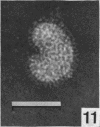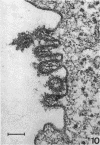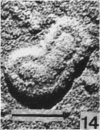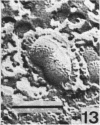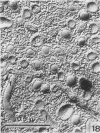Abstract
The budding of a tumor-adapted strain of influenza A0 virus at the surface of Ehrlich ascites tumor cells was studied by electron microscopy. Thin sections of budding sites showed the formation of a fuzzy coat on the outside of the cell membrane and simultaneously the apposition of a dark layer on the inner side. The continuity of cellular and viral membrane seemed to be preserved up to the point where the virion remained attached by only a thin stalk. Freeze-etching of virus budding sites yielded pictures in which a clear differentiation between the viral membrane and the host cell membrane was visible. The breaks across the fuzzy coat revealed striations corresponding to the “spikes” seen in negative contrast, whereas tangentially broken virus particles were best interpreted by assuming that splitting occurred midway between the two outer layers of the envelope.
Full text
PDF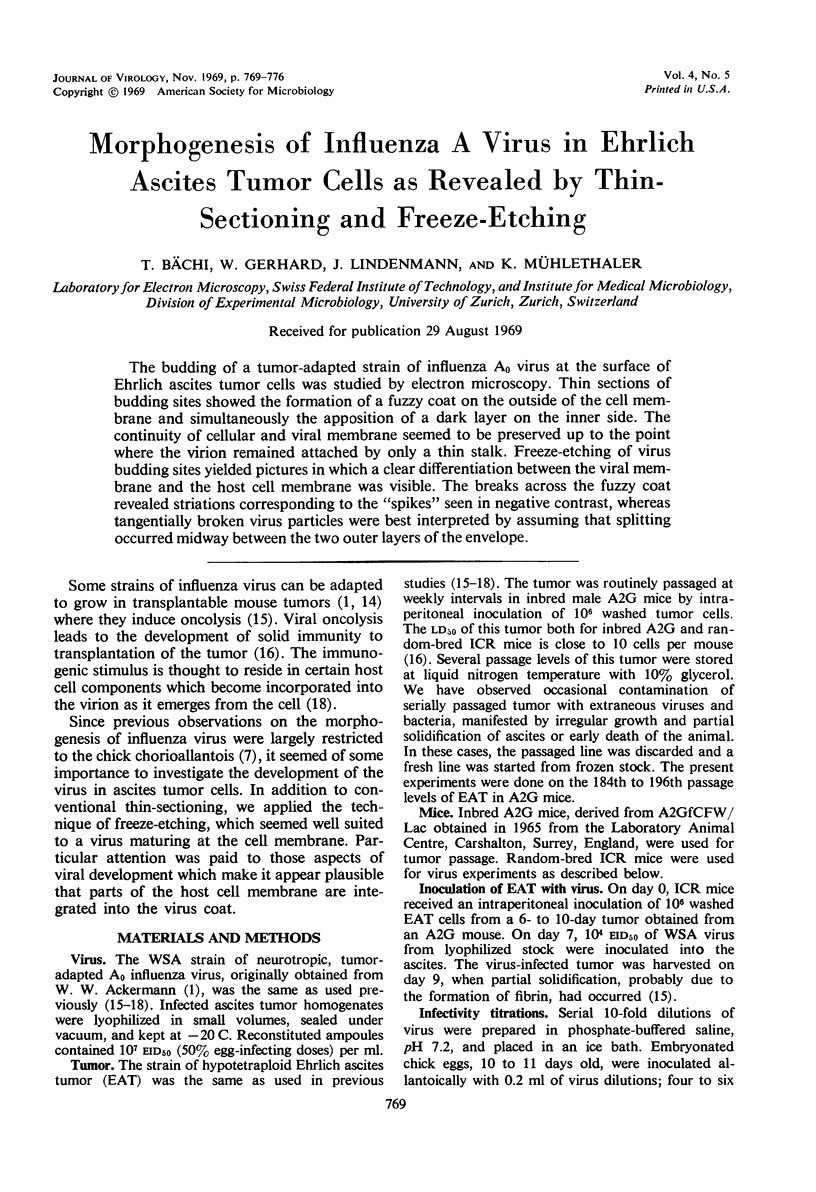







Images in this article
Selected References
These references are in PubMed. This may not be the complete list of references from this article.
- ACKERMANN W. W., KURTZ H. A new host-virus system. Proc Soc Exp Biol Med. 1952 Nov;81(2):421–423. doi: 10.3181/00379727-81-19897. [DOI] [PubMed] [Google Scholar]
- APOSTOLOV K., FLEWETT T. H. INTERNAL STRUCTURE OF INFLUENZA VIRUS. Virology. 1965 Jul;26:506–508. doi: 10.1016/0042-6822(65)90014-0. [DOI] [PubMed] [Google Scholar]
- Almeida J. D., Waterson A. P. A morphological comparison of Bittner and influenza viruses. J Hyg (Lond) 1967 Dec;65(4):467–474. doi: 10.1017/s0022172400046003. [DOI] [PMC free article] [PubMed] [Google Scholar]
- Almeida J. D., Waterson A. P. Some observations on the envelope of an influenza virus. J Gen Microbiol. 1967 Jan;46(1):107–110. doi: 10.1099/00221287-46-1-107. [DOI] [PubMed] [Google Scholar]
- Apostolov K., Flewett T. H. Further observations on the structure of influenza viruses A and C. J Gen Virol. 1969 Apr;4(3):365–370. doi: 10.1099/0022-1317-4-3-365. [DOI] [PubMed] [Google Scholar]
- Branton D. Fracture faces of frozen membranes. Proc Natl Acad Sci U S A. 1966 May;55(5):1048–1056. doi: 10.1073/pnas.55.5.1048. [DOI] [PMC free article] [PubMed] [Google Scholar]
- HORNE R. W., WATERSON A. P., WILDY P., FARNHAM A. E. The structure and composition of the myxoviruses. I. Electron microscope studies of the structure of myxovirus particles by negative staining techniques. Virology. 1960 May;11:79–98. doi: 10.1016/0042-6822(60)90056-8. [DOI] [PubMed] [Google Scholar]
- HOTCHIN J. E., COHEN S. M., RUSKA H., RUSKA C. Electron microscopical aspects of hemadsorption in tissue cultures infected with influenza virus. Virology. 1958 Dec;6(3):689–701. doi: 10.1016/0042-6822(58)90115-6. [DOI] [PubMed] [Google Scholar]
- HOYLE L. The release of influenza virus from the infected cell. J Hyg (Lond) 1954 Jun;52(2):180–188. doi: 10.1017/s0022172400027388. [DOI] [PMC free article] [PubMed] [Google Scholar]
- Haukenes G., Harboe A., Mortensson-Egnund K. A uronic and sialic acid free chick allantoic mucopolysaccharide sulphate which combines with influenza virus hi-antibody to host material. 1. Purification of the substance. Acta Pathol Microbiol Scand. 1965;64(4):534–542. doi: 10.1111/apm.1965.64.4.534. [DOI] [PubMed] [Google Scholar]
- LINDENMANN J. IMMUNITY TO TRANSPLANTABLE TUMORS FOLLOWING VIRAL ONCOLYSIS. I. MECHANISM OF IMMUNITY TO EHRLICH ASCITES TUMOR. J Immunol. 1964 Jun;92:912–919. [PubMed] [Google Scholar]
- LINDENMANN J. Viral oncolysis with host survival. Proc Soc Exp Biol Med. 1963 May;113:85–91. doi: 10.3181/00379727-113-28284. [DOI] [PubMed] [Google Scholar]
- Lindenmann J., Klein P. A. Viral oncolysis: increased immunogenicity of host cell antigen associated with influenza virus. J Exp Med. 1967 Jul 1;126(1):93–108. doi: 10.1084/jem.126.1.93. [DOI] [PMC free article] [PubMed] [Google Scholar]
- MOLLENHAUER H. H. PLASTIC EMBEDDING MIXTURES FOR USE IN ELECTRON MICROSCOPY. Stain Technol. 1964 Mar;39:111–114. [PubMed] [Google Scholar]
- MOOR H. DIE GEFRIER-FIXATION LEBENDER ZELLEN UND IHRE ANWENDUNG IN DER ELEKTRONENMIKROSKOPIE. Z Zellforsch Mikrosk Anat. 1964 Apr 28;62:546–580. [PubMed] [Google Scholar]
- Moor H. Freeze-etching. Int Rev Cytol. 1969;25:391–412. doi: 10.1016/s0074-7696(08)60209-0. [DOI] [PubMed] [Google Scholar]
- REYNOLDS E. S. The use of lead citrate at high pH as an electron-opaque stain in electron microscopy. J Cell Biol. 1963 Apr;17:208–212. doi: 10.1083/jcb.17.1.208. [DOI] [PMC free article] [PubMed] [Google Scholar]
- Staehelin L. A. The interpretation of freeze-etched artificial and bilogical membranes. J Ultrastruct Res. 1968 Feb;22(3):326–347. doi: 10.1016/s0022-5320(68)90025-7. [DOI] [PubMed] [Google Scholar]












